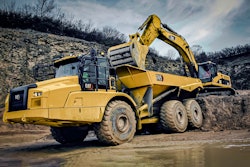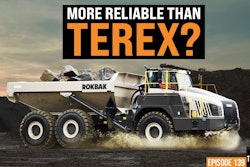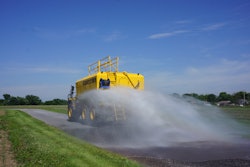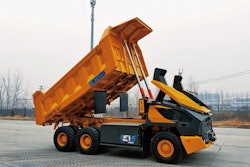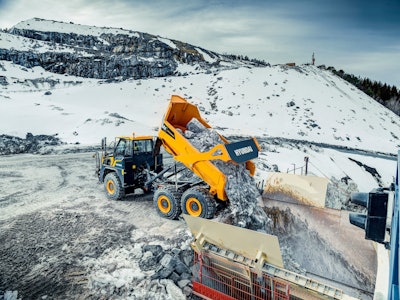
Articulated dump trucks are built for hauling off-road and would seem to have no room for giant leaps in performance. Refinement, however, continues unabated, and autonomous operation is an ever-larger objective.
In this report, we take a look at the latest articulated haulers on the market – from Bell, Cat, Develon, Hyundai, John Deere and Volvo – and their new technology.
We also get some answers on how soon we can expect autonomous ADTs for construction.
Bell Focused on Worksite Safety
 Bell offers three-axle 6x6 drive in its six of its models, but the 577-horsepower B60E is defined as a “crossover solution” for those who don’t need the “go anywhere” performance of the 6x6 models. The B60E enables work in places other trucks can’t go. Rated payload is 60 tons. Heaped capacity is 45.8 cubic yards.Bell Equipment
Bell offers three-axle 6x6 drive in its six of its models, but the 577-horsepower B60E is defined as a “crossover solution” for those who don’t need the “go anywhere” performance of the 6x6 models. The B60E enables work in places other trucks can’t go. Rated payload is 60 tons. Heaped capacity is 45.8 cubic yards.Bell Equipment
A PDS alerts the operator when it detects a person or object near the truck. The alerts are visual and audible and are intended to ensure the operator’s situational awareness includes the proximity of whatever triggered those alerts. It is up to the operator to modify truck operation as required.
The CAS will exert control over operation by either slowing or stopping the truck to avert collision or minimize the consequences of impact.
“Our Pin 3 E-series ADTs introduced toward the end of 2020 are built ready to integrate with a wide range of proximity detection systems or collision avoidance systems up to Level 9,” says Pett.
Bell provides a PDS gateway controller (ISO 21815-2) for connecting a third-party PDS/CAS. Commands from that system are communicated to the truck, where Bell systems implement the indicated actions, such as retardation or applying the service brakes. Older trucks from the D-series Pin 4 can be retrofitted with a PDS aftermarket kit.
Pett says this is a natural progression, as earlier E-series trucks already introduced a host of advanced features, such as automatic traction control and automatic speed control and retardation.
Cat Offers Full Suite of Advanced Features
 The Caterpillar 745 is powered by a Cat C18 rated at 504 horsepower. Payload rating is 45.2 tons, and heaped capacity is 32.7 cubic yards. A uniquely combined hoist and transmission lever requires up to 50% less operator input and is one of several features making the 745 suitable for a wide range of operator experiences.Caterpillar
The Caterpillar 745 is powered by a Cat C18 rated at 504 horsepower. Payload rating is 45.2 tons, and heaped capacity is 32.7 cubic yards. A uniquely combined hoist and transmission lever requires up to 50% less operator input and is one of several features making the 745 suitable for a wide range of operator experiences.Caterpillar
Another feature, Assisted Hoist, can be engaged if the truck is stopped or traveling less than 2 mph. The feature shifts the truck to neutral, applies the service brakes, brings the engine to full rpms and raises the bed. Assisted Hoist can be switched on and off by the operator.
Cat ADTs also have engine compression braking with automated retarder control. ARC engages automatically when the operator’s foot is lifted off the accelerator pedal and will maintain downhill speed using engine braking, adding service brake application as required.
Traction control is fully automatic and integrated with steering to prevent the “plowing” effect traction control can otherwise exert while the truck is turning.
Develon’s DA45-5 as Design Showcase
 The Develon DA45-5 features a front-mount turning ring, sloping rear frame and free-swinging rear tandem bogie for improved weight distribution and full-time six-wheel ground contact. The Scania DC13 engine is rated at 483 net horsepower. Rated payload is 45 tons. Body capacity is 31.9 cubic yards without tailgate.Develon
The Develon DA45-5 features a front-mount turning ring, sloping rear frame and free-swinging rear tandem bogie for improved weight distribution and full-time six-wheel ground contact. The Scania DC13 engine is rated at 483 net horsepower. Rated payload is 45 tons. Body capacity is 31.9 cubic yards without tailgate.Develon
The hydro-gas self-levelling front axle and bogie rear wheel axles deliver traction and stability in extreme ground conditions. The bed has a 6-degree slope for improved safety and efficiency.
Sherman says the company remains bullish despite faltering numbers in other parts of the economy. “Right now, the sectors being hit hardest are consumer-oriented products, while essential commercial products remain relatively strong.”
He says several factors support the equipment market, most notably the $1 trillion infrastructure bill that has launched 40,000 projects in its first two years. “We’re even adding equipment to our portfolio.” He noted that Develon announced last year it was introducing its first compact track loader.
Hyundai: Newcomer to ADT Market
In June 2022, Hyundai Construction Equipment North America announced entry into the articulated dump truck market with the HA30 and HA45 models as part of a collaboration with Hyundai Doosan Infracore – now Develon. (Both companies have since been renamed; learn more here.) The HA30 and HA45 trucks began arriving at dealers in 2023. They share the signature bogie rear axles and hydro-gas self-levelling front axle with their Develon counterparts.
Other features include limited-slip front and rear differentials and a longitudinal differential that can be manually locked. The front diff is integrated into the ZF transmission, resulting in a shorter front frame section for a tighter turning radius. That eight-speed transmission has torque converter lockup in all gears. The engine canopy tilts forward, and the entire cab structure tilts toward the rear of the truck for roomy service access.
Hyundai’s timing was a response to high demand. “We see growth in the under-30-ton segment of nearly 50% and in the over-40-ton segment of about 35%,” says Joe Hodges, product manager, HD Hyundai Construction Equipment North America. He says rental and housing are the two main drivers of this demand. “We don’t yet have year-over-year sales figures, but our dealers and customers have been very receptive to the trucks, and our sales have been strong.”
ADTs Join Deere’s Tier Strategy
 The 460 P-Tier from John Deere provides up to 7% better fuel efficiency in all three drive modes compared to previous models. Updated machine sensors and improved routing of hydraulic hoses and electrical harnesses enhance reliability, the company says. The Deere PowerTech 6135 engine is rated at 481 net horsepower. Rated payload is 46 tons; heaped capacity is 32.9 cubic yards.John Deere
The 460 P-Tier from John Deere provides up to 7% better fuel efficiency in all three drive modes compared to previous models. Updated machine sensors and improved routing of hydraulic hoses and electrical harnesses enhance reliability, the company says. The Deere PowerTech 6135 engine is rated at 481 net horsepower. Rated payload is 46 tons; heaped capacity is 32.9 cubic yards.John Deere
On the 410 P-Tier and 460 P-Tier, the bin is wider and maintains the same profile front to back for improved loading and material retention.
There is not, at this time, any plans for G- or X-Tier models, as the P-Tier platform serves ADT customers well, says Matt Costello, solutions marketing manager. (G-Tier are basic machines. P-Tier includes performance and comfort features for production and other heavy-use applications. X-Tier has the company’s most advanced technologies and features.)
That’s not to say P-Tier models are allowed to stagnate.
“P-Tier Generation A was introduced in 2023,” says Costello. “Refinement is ongoing as we get input from customers and to reflect shifts in the market as a whole.”
Greater understanding of how Deere ADTs are used is part of this process, and improved telematics contribute to this understanding. JDLink has been rebranded Operations Center to reflect the broader data gathering and reporting abilities of Deere telematics. It is customizable to match customer needs in monitoring and reporting and provides real-time monitoring at the dealer level. This supports Deere’s efforts in refining P-Tier machines, says Costello. “We want to know which features are being used and which are not, and why not.”
Deere offers packages to suit specific applications. These include debris, cold weather, and maintenance and service packages. A scraper option is offered for the 460 P-Tier truck. That 3812 scraper holds 38 cubic yards, is 12 feet wide and replaces the bin on the back of the ADT. The multifunction joystick is used for scraper operations but can be changed back to ADT functions if the truck is converted back to an ADT.
Autonomous ADTs Coming?
Articulated dump trucks’ duty cycles would seem to make them good candidates for autonomous operation.
But are they?
“Autonomous is on our radar,” says Thomas of Caterpillar, “but there’s still a lot of hesitation from customers, largely due to infrastructure demands needed to achieve an autonomous worksite.”
And unlike trucks used in quarry, aggregate and mining applications, ADTs’ worksites move a lot and lack homogeneity. Also, the market doesn’t agree on what “autonomous” entails.
“Is that a supervisor on site with visual line-of-sight to every piece of equipment? Is that a remote supervisor watching everything on a screen? Does it mean each piece of equipment is not only aware of every other piece but is also communicating and interacting with them in real time?” Thomas says there’s a lot to be sorted out before the autonomous worksite becomes a reality, much less commonplace.
Jake Sherman, with Develon, says the company uses X1 and X2 internally to denote the level of development of autonomous equipment. As evidence of the compatibility between autonomous and non-autonomous equipment, Sherman says, the Develon X1 and X2 dozers and excavators work well with the DA45-5 ADT.
“The demand is there for autonomous worksites, but the industry is still early in the development phase.” He says Develon is more focused on equipment requiring advanced operator skills, such as dozers and excavators, driven largely by the persistent shortage of skilled operators. The speed of autonomous systems, which is controlled mostly by processor speed, is a limiting factor now, he adds.
As autonomous equipment arrives at worksites, will contractors without autonomous machines be able to compete?
“In the short term, yes,” says Sherman. “But as the technology progresses and broadens, it will become harder to compete without it.”
Hodges says that although HD Hyundai, the global parent company, has no autonomous equipment now, “we have been doing a lot with automation and remote control across all construction equipment lines and will introduce those features to our North American customers as they become available.”
HD Hyundai exhibited some of these forward-looking technologies at the 2024 Consumer Electronics Show in Las Vegas; see our coverage here.
Costello says that while “autonomous” is a discussion relevant to the industry and that Deere pursues new solutions, the company is focused on features that assist the human operator, “and that’s where we’ll be for some time to reflect the persistent shortage of skilled operators.”
For example, the operator selects Normal, Eco or Traction mode and the truck’s logic manages the locking differential, braking and other operations automatically. Shift-on-the-fly is also automatic; the operator can select a gear at any time, but the truck will not shift until specific parameters, including travel speed, are met.
 The 45-ton Volvo A45G has a Volvo D16J engine rated at 469 gross horsepower. Volume is 32.8 cubic yards. The A45G includes key functional updates added in 2020, including downhill speed control, cruise control and reverse by braking. Use of Volvo filters and oil extend PM intervals to 1,000 hours. A swing-down front grill and electric hood opening to 90 degrees provide roomy service access.Volvo Construction Equipment
The 45-ton Volvo A45G has a Volvo D16J engine rated at 469 gross horsepower. Volume is 32.8 cubic yards. The A45G includes key functional updates added in 2020, including downhill speed control, cruise control and reverse by braking. Use of Volvo filters and oil extend PM intervals to 1,000 hours. A swing-down front grill and electric hood opening to 90 degrees provide roomy service access.Volvo Construction Equipment




